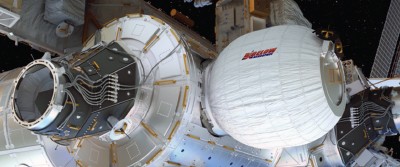Inflatable Module Attached to Space Station

By Hamilton Waldron
Last month, NASA added an extra room to the side of the International Space Station. Now that the installation of the Bigelow Expandable Activity Module (BEAM) is complete, NASA will soon expand the room to its maximum size of 13 feet long and 10 feet in diameter, providing astronauts an extra 556 cubic feet of room to move around for the experiment’s two-year duration.
Made of materials that help make it resistant to impact, these lightweight habitats could help save millions of dollars in launch costs and may also aid astronauts in protecting against radiation. In fact, BEAM will soon undergo a special test run intended to measure how it withstands the temperature swings and high-radiation environment of space.
Timeshares in Space?
Bigelow Aerospace, the manufacturer and owner of the 3,100 pound module, has previously tested two other prototypes, but BEAM is its first inflatable to host astronauts. Owned by real estate billionaire Robert Bigelow, the company is also working on modules that are up to 20 times larger than BEAM.
The company is also developing timeshare agreements that will allow commercial entities, research organizations and even some space tourists to lease the inflatable rooms. Bigelow plans on making NASA the primary customer, since NASA is still working on establishing habitable living quarters for its planned three-year trips to and from Mars.
Speaking of trips to Mars, the biggest potential obstacle for BEAM is how it will fare during long stays in microgravity. It’s for this reason that the BEAM includes a suite of sensors that will gather data about the habitat’s time at the station. Astronauts on board the ISS are expected to enter the BEAM three to four times a year, at which time they’ll be able to collect the info for NASA and Bigelow.
Once all the tests have been completed and the inflatable room reaches the end of its two-year duration, the BEAM will be detached from the station and eventually burn up in the Earth’s atmosphere.
CLASSROOM DISCUSSION
Discuss the pros and cons of a potential controlled habitat for “tourist trips” to space.
Research other prototypes that Bigelow Aerospace has previously tested.
VOCABULARY
- BEAM
- Bigelow Aerospace
- Microgravity